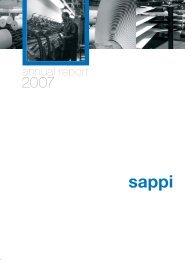2012 Integrated report - Sappi
2012 Integrated report - Sappi
2012 Integrated report - Sappi
You also want an ePaper? Increase the reach of your titles
YUMPU automatically turns print PDFs into web optimized ePapers that Google loves.
iodiversity<br />
Sustainable fibre supply<br />
Together with energy and water, woodfibre is the most important<br />
input into our production processes. Consequently, ensuring<br />
sustainable fibre supply is a key priority for our business.<br />
Against the backdrop of increasing concerns globally about<br />
the deforestation of endangered tropical forests, the use of<br />
internationally recognised, independently verified forest<br />
certification systems gives us an important competitive edge.<br />
The forest certification systems we use include the Forest<br />
Stewardship Council (FSC), Programme for the Endorsement<br />
of Forest Certification (PEFC) and Sustainable Forestry Initiative ®<br />
(SFI ® ). Globally, our use of certified fibre stands at 70.2%, with<br />
the balance procured from known and controlled sources.<br />
Europe<br />
In this region we do not own plantations or land. Woodfibre is<br />
predominantly sourced from forests in the regions in which our<br />
mills are located. Softwood and hardwood pulp is sourced from<br />
Europe and the Americas. The main wood species used include<br />
spruce (used for mechanical pulp and softwood chemical pulp)<br />
and beech (used for hardwood pulp). Lanaken Mill can also<br />
process significant amounts of poplar. Market pulp species<br />
are predominantly eucalyptus, pine and spruce.<br />
North America<br />
As in Europe, in this region we do not own forest plantations or<br />
land. Wood is sourced from landowners and commercial loggers<br />
in the temperate forests of Maine, New Hampshire, Michigan,<br />
Minnesota and Wisconsin and from the Canadian provinces of<br />
New Brunswick, Quebec and Ontario. The tree species used in<br />
this region include maple, poplar, aspen, beech and birch<br />
(hardwoods) and spruce, pine and fir (softwoods).<br />
In both Europe and North America, we mitigate fibre supply risk<br />
through a combination of approaches which include both short<br />
and long term wood supply agreements and shareholdings in<br />
wood sourcing cooperatives and companies.<br />
Southern Africa<br />
We source woodfibre from plantations (planted forests of exotic<br />
trees) of softwoods and hardwoods. In this region, owning,<br />
managing and leasing 554,000ha of land gives us a high degree<br />
of self-sufficiency in woodfibre. We supply approximately 70%<br />
of our own fibre requirements. In addition we are:<br />
> Investing around US$7.5 million a year to rehabilitate our<br />
52,000ha Usutu plantation in Swaziland, almost half of which<br />
was destroyed by fires in 2007 and 2008<br />
> Promoting Project Grow, a small grower initiative, which<br />
currently supplies 2% of our total timber requirements – the<br />
value of the standing timber currently covered by the scheme<br />
is approximately US$36 million<br />
> Assisting with land reform projects on which timber is grown<br />
> Mitigating the risk of climate change through our tree<br />
improvement programmes which have resulted in the<br />
development of hybrids, allowing us to closely match species<br />
to site and to a variety of climatic conditions including drought.<br />
> Lowering costs by improving yield:<br />
– Over 15 years, our research efforts have resulted in a<br />
60% improvement in eucalypt plantation yield.<br />
– In our Usutu pine plantations we have maintained sample<br />
plots to allow comparison of four successive rotations of<br />
pine since the first rotation planted in the 1950s. The latest<br />
measurements taken in 2011 indicate an 8% yield<br />
improvement – consistent with the expectation from<br />
genetically superior planting stock and measures taken<br />
to maintain site productivity.<br />
> Since the devastating fires experienced in 2007 and 2008, we<br />
have implemented a more aggressive, extensive fire protection<br />
strategy. Risks are now managed via an integrated Fire Risk<br />
Management System comprising a comprehensive risk<br />
assessment, monthly compliance checks for monitoring,<br />
management procedures, standards, and general back-up<br />
information. We have also increased community participation<br />
in fire prevention activities.<br />
Biodiversity<br />
According to the Convention on Biodiversity, “biological diversity<br />
– or biodiversity – is the term given to the variety of life on Earth<br />
and the natural patterns it forms ... Biodiversity also includes<br />
genetic differences within each species – for example, between<br />
varieties of crops and breeds of livestock. Chromosomes, genes,<br />
and DNA – the building blocks of life – determine the uniqueness<br />
of each individual and each species.”<br />
Biodiversity is key to the healthy functioning of the plantations<br />
(in South Africa) and managed natural forests (Europe and North<br />
America) from which we source woodfibre. Neither our<br />
plantations nor managed natural forests would be productive<br />
without biotic processes taking place. Both our plantations and<br />
managed natural forests are actively managed to enhance these<br />
beneficial processes and restrict harmful processes like pests<br />
and disease.<br />
> Working with communities in the Eastern Cape to establish<br />
30,000ha of plantations – a project in line with Government’s<br />
goal of driving rural development<br />
sappi <strong>Integrated</strong> Report <strong>2012</strong> 21
















